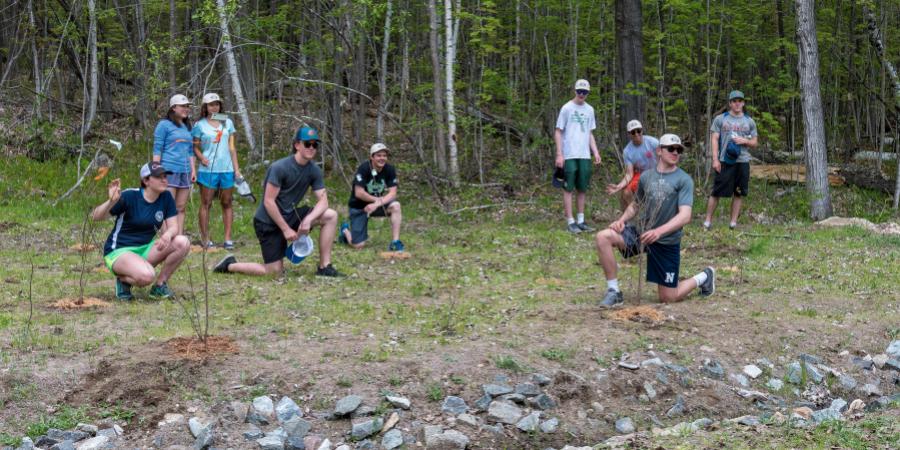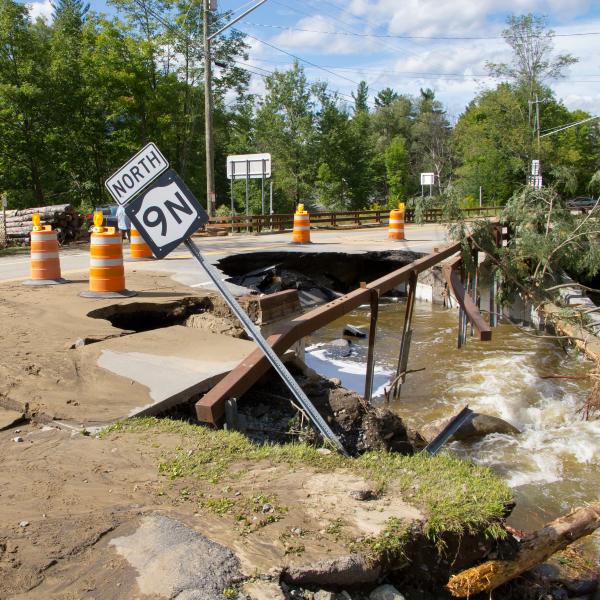For many years, the Ausable River Association has advocated for healthy streams with cool, shaded waters, open floodplains, and self-regulating flows to sustain ecological diversity and our thriving communities. We use multiple approaches to achieve this goal, but one of the most visible is our stream restoration effort. Large scale projects on both the East and West Branch Ausable River that rebuild channel form and function, and replacement of undersized pipe culverts in ways that allow streams to flow freely under our roads. There's no doubt that the Ausable is a beautiful system capable of supporting people, wildlife, and multiple recreational uses, but it is also a river struggling to maintain its resilience – a self-regulating balance. In large part, this is due to historic land clearing and dredging for industry, floodplain development, and the existence of roads, culverts, bridges, dams, and communities that limit floodplain access.
Lack of stability in a stream system like the Ausable has ecological and financial costs. Undersized culverts block fish passage, exacerbate erosion, and collect debris that blocks water flow during storms. This blockage can flood roads, and increase costs to our towns. Sand, gravel, cobble, and boulders from rapidly eroding riverbanks fill delicate pool habitats and pile cobble in shallow riffles which widens channels and cuts off access to floodplains. While some erosion is natural in every stream system, large scale erosion leaves banks vulnerable; channels widen, habitat is smothered, and flood resilience for our communities declines, while maintenance costs mount.
AsRA's goal is to provide long-lasting and low maintenance solutions for communities while restoring form, function, and riparian structure to our streams. We can replace undersized culverts, repair eroding banks, reconnect streams to floodplains, and restore form and function by using hydrologic and geomorphic models and surveys to inform our methods. What's left however, immediately after construction of many projects, is a restored channel with newly rebuilt banks waiting to regain their riparian structure – the diverse plants that are essential to stream health.

Exposed cobble and toe wood at the Riverlands restoration site catch debris to begin soil building.
The faster these banks develop a diverse plant and tree community, the more successful the restoration effort. Once twigs, leaf litter, and other detritus from the river start to decompose, an initial thin layer of soil builds on top of the cobble and gravel of the new streambank. This is augmented by sediment deposition from spring floods. Seeds from native plants in the surrounding area find their way to this new habitat by wind, water, or wildlife and start to colonize. Grasses, shrubs, and trees provide the initial root systems that will stabilize the new soil layer and bind the natural materials from which the banks are constructed. As the riparian ecosystem and its underground root system grows more complex, it holds soil in place and protects bank and channel structure. We don’t want to wait, however, for this slow natural process; instead, we want to jump start the regrowth of dense native vegetation.
AsRA’s staff are interested in finding the most efficient way to get these banks revegetated as quickly as possible, using native plants specific to our region, so that our restoration projects have the best success and longevity possible. This season, AsRA received funding from the Lake Champlain Basin Program to evaluate diverse planting methods for future restoration sites. Our goal is to find the native species and the methods for introducing them that maximizes revegetation success while minimizing time, energy, and money needed to maintain revegetated areas. To assist in this process, we are working with local botanist Steve Langdon. Together, we are testing different care methods on various tree species to determine the effects on tree growth.
River Steward Liz Kamb and Biodiversity Research Manager Carrianne Pershyn finish up planting at the Riverlands restoration site in June.
AsRA’s staff worked with Steve to select tree species that do well in local riparian ecosystems and that have some level of tolerance to disturbance. The species selected include northern white cedar, quaking aspen, red maple, black willow, speckled alder, and American elm. Individual trees were distributed evenly across the 2014 Riverlands restoration site. We then used a US Fish and Wildlife Service protocol to set up transects at the site to tag and monitor the growth of trees at this site over time. In June 2019, 100 trees were planted at the Riverlands restoration site and we randomly applied a care regime to each tree. All trees get mulched and watered on the day of planting, but we added blue tree tubes to some and marked half of all the trees to be watered bi-weekly. The tree tubes protect saplings from moisture loss, damage from solar radiation, predation by animals and some insects, and promote photosynthesis.

White tape on this quaking aspen (Populous tremuloides) seedling indicates it should be watered bi-weekly.
In the future, AsRA’s staff will be able to determine which treatment allows for the best tree survival while minimizing cost and time commitment to maintaining trees. Ideally, we will be able to determine not only which method is most efficient, but also which tree species have the best survival rate with different levels of care. By planting more of the most successful tree species and maintaining them with the most efficient methods we know, we can maximize the rate of growth of new riparian habitats, the protection of streambanks, and, therefore, the long-term success of AsRA’s restoration projects.
River Steward Liz Kamb and summer intern Davi Bendavid settle in for an afternoon of tree monitoring at the Coonradt restoration site.
We have already seen promising results from our pilot season of tree monitoring. Trees are monitored throughout the growing season using a survey system that accounts for tree height, condition, stem browse, leaf browse, girdling, and competitive surrounding species. There is not much to be detected yet in terms of vertical growth, but the young trees leafed out and suffered minimal leaf and stem browse from insects and other wildlife this summer. Additionally, most trees ranged from 70-100 percent condition (with 100 percent signifying a completely healthy tree and zero percent signifying a dead tree), which is fantastic after a first growing season. We cannot yet determine which species or which treatments will be most successful over time, but these results will become clear as tree monitoring continues in future growing seasons.
Summer intern Davi Bendavid measures tree height while River Steward Liz Kamb records monitoring data.
Thanks to funding from the Lake Champlain Basin Program and many hours of fieldwork by AsRA’s staff and Steve Langdon, our first tree planting experiment is launched! We are looking forward to discovering the results of this program and what they mean for the success and longevity of our restoration efforts on the Ausable River. We hope that the successful growth on these riparian banks will ensure bank and channel stability, enrich habitat, and shade our waterways, allowing the river to find and maintain its equilibrium and manage storm flows.
Sign-up for our e-newsletter to get weekly updates on the latest stories from the Ausable River Association.







